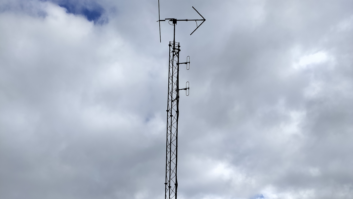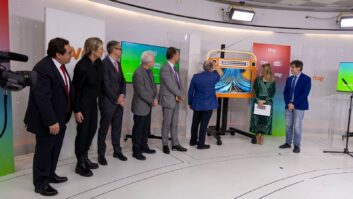(click thumbnail)Integrating the world of Web-based social networking with DAB radio: That is the goal of the innovative “Olinda” prototype radio. Designed and built by London’s Schulze & Webb Limited, the multisegmented Olinda is designed to let listeners Web-connect to friends in real time. By doing so, Olinda users can share the programs and stations they are listening to, says Matt Webb, principal at Schulze & Webb.
“Imagine it is 10:30 p.m. and I notice that one of the Olinda’s six ‘Listening Friends’ lights is activated on my radio,” Webb said.
“Curious as to what he’s listening to, because each light is assigned to a specific friend, I turn on my Olinda-based receiver and the same program comes on. This serves two functions. First, it allows us to share content, just as people share favorite bookmarks on the Web. Second, we share the experience of listening to the same content, and can communicate about it on the Web as we do.”
Concept
(click thumbnail)The impetus and money for the Olinda prototype radio came from the BBC’s Audio and Music Interactive division. “The BBC put out a tender a year ago, looking for a prototype radio that would help advance DAB listenership and take radio into the future,” Webb said. “We won the tender based on two ideas; that the radio of the future would foster social networking among listeners, and that it would be modular in design to allow for new features to be added over time.”
The four working Olinda prototypes embody both of these ideas. First, Olinda is equipped with a built-in Wi-Fi connection. It links directly to Radio Pop, the BBC’s Web site for sharing “now playing” information. Each of the six Listening Friends lights also serves as an access button: To hear what they are hearing, just push the button. “The lights are bright so you’ll know that a friend has started listening from across the room,” said Webb.
Second, the Olinda radio is made up of modular sections; each with side-mounted jacks that allow them to snap-connect to each other. At present, the prototype has two segments. The first contains the radio’s main functions, including the DAB chip, tuning equipment, LCD display screen, speaker, and antenna. The second module contains the social networking software, lights, and Wi-Fi connection. It is terminated with a clear plastic orange plate that shows the available ports on the unused end. “Being able to see the ports communicates to the user that more modules can be added,” he noted.
Possibilities
As envisioned by Schulze & Webb, many functions could be built into the Olinda’s dockable modules. They include:


- Klipit: This might be a large button that the listener pushes, resulting in the station ID and current time being sent to an online “Klipit” service. This data along with the track title and other pertinent information could then be sent to the listener, allowing him to purchase and download the item.
- Push-to-talk: This would be an online Web-connected “intercom” that would let the listener talk to up to six Listening Friends through the Olinda.
- Recommendation Buddy: This device would track the listener’s preferred stations and recommend others that might suit his tastes.
- Pause: This feature would let the listener pause a live program, recording it for playback at a later time in much the same way a DVR works.
- Mobile phone/MP3 player dock: This would charge either device, and allow Olinda-based programming to be transferred into them for later playback.
- Profile key fob dock: This is a USB key that plugs into the Olinda, recording the owner’s station preferences. The owner could then carry, plugging it into other Olinda-enabled receivers (such as one in a car).
Reality check
In its present form, the Olinda prototype radio seems unlikely to ever hit store shelves. But that is fine with Matt Webb. This version is designed to stimulate discussion and commercial derivations; much like a concept car becomes the basis of actual models later on. This is why the BBC will be taking the Olinda along to conferences and trade shows, to get people talking.
“It is the ideas embodied in the Olinda that we hope to popularize,” he said. “Our goal is to get people thinking about the social networking possibilities of radio, and how this new trend can be applied to traditional broadcast listening. After all, the notion of having social groups built around radio is nothing new. In fact, it hearkens back to the early days of the medium, when the family would gather around the set, listening and laughing together. The Olinda offers a 21st century spin on this approach by using social networking via the Web, but the underlying thinking is as old as radio itself.”
For more information about the Olinda prototype radio, go to schulzeandwebb.com/2008/olinda.












